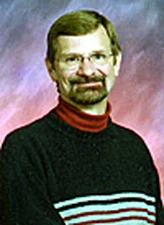David L. Kohlstedt

The 2005 Louis Néel Medal is awarded to David L. Kohlstedt for his pioneering research in deformation processes in minerals and rocks, establishing a fundamental physical basis for the rheology of the upper mantle and tectonic processes in oceanic ridges.
Prof. David L. Kohlstedt is a major figure in the international community of rock deformation researchers. He is one of only a handful of scholars who have made brilliant use of condensed matter physics to make seminal discoveries in the roles of point defects, water content and intergranular melt migration in the shear deformation of the lower crust and uppermost mantle of the Earth. It is a distinct pleasure and an honor for me, therefore, to nominate Prof. Kohlstedt for the award of the 2005 Louis Néel Medal of the EGU.
One of the hallmarks of Louis Néel’s contributions to the theory of magnetic ordering in solids and to the application of magnetic relaxation phenomenology in fine particles of synthetic and natural origin was a firm grounding in fundamental physics and an elegant extension of such physics into increasingly complex materials. From my personal experience as a colleague of David’s for the last fifteen years, I can say with confidence that these characteristics of Néel’s are also evident in the research and scholarship of David Kohlstedt. As a graduate student in the physics department of the University of Illinois (Urbana) and as a postdoctoral research associate in the Cavendish Laboratory in Cambridge, England, David used transmission electron microscopy as a tool and condensed matter physics as the theoretical basis for investigating the hardness and deformation mechanisms in transition metal carbides. Bill Brace at MIT invited David to join the rock deformation group in Cambridge U.S.A. where, in collaboration with Chris Goetze, David published a series of papers on the nature of low-stress-elevated-temperature creep in olivine crystals, the major mineral component of the upper mantle. The results he then published allowed one to understand the atomic nature of creep in the upper mantle and to achieve a confident extrapolation to estimate mantle viscosity, a parameter so crucial to models of mantle convection.
This early model, attacking a gross-earth problem by identifying the dominant variable and experimentally studying its impact on a well-characterized “clean” sample, can be seen repeatedly in David Kohlstedt’s research career, first at Cornell and then at Minnesota for the 30 years following his stay at MIT. A Guggenheim fellowship to visit with the (then) doyen of high-temperature, high-pressure deformation, Prof. Mervyn Patterson of Australian National University, led David to initiate a long duration intensive study of the role of water in nominally anhydrous mantel minerals. With his postdocs and graduate students, David Kohlstedt expanded his research subjects to become more representative of the “real” mantle by including parameters such as point defects, chemical composition, partial melts, melt migration under deformation, melt segregation at grain boundaries, and to his current research on the physics of fluid migration in the “real” mantle of the Earth. Through his publications in Nature, Science, and a few highly esteemed review journals, and with the collaboration of Steve Mackwell, Greg Hirth, Mark Zimmerman, Ben Holtzman and others, David Kohlstedt has provided a definitive picture of the strength of the lithosphere, rheology of the oceanic upper mantle and the dynamics of melts in the Earth’s mantle. And as if the Earth was not enough, David Kohlstedt has been steadily expanding his research to include dry diabase as a model for Venus, and ice as a model for Io.
In addition to being a trail-blazer in global research on rock deformation, David has been a model advisor to some of the best known younger scholars in the field, some of whom are mentioned in the paragraph above. His modesty, his ability to listen and respond to comments and criticisms from all colleagues both junior and senior to him, and his legendary availability to his students have been laudatory. In the department of geology and geophysics at Minnesota, David Kohlstedt has carried admirably a heavy responsibility as graduate studies advisor as well as being a critical figure behind the department’s success in being chosen by the National Science Foundation as a funded site for Research and Undergraduate Education (REU). Internationally, David Kohlstedt has been much in demand for seminars and longer stays in Germany, France, Japan and Australia. His contributions to the world-wide research community have been of incredibly high quality and broad impact.
